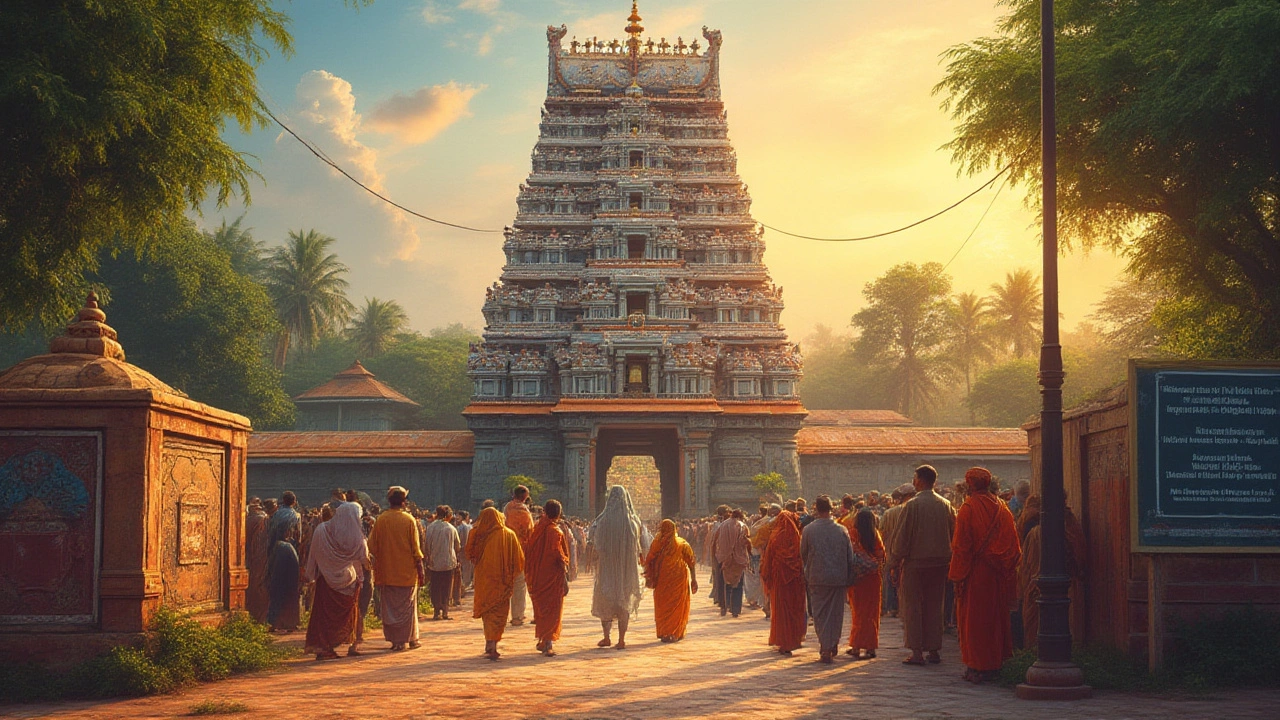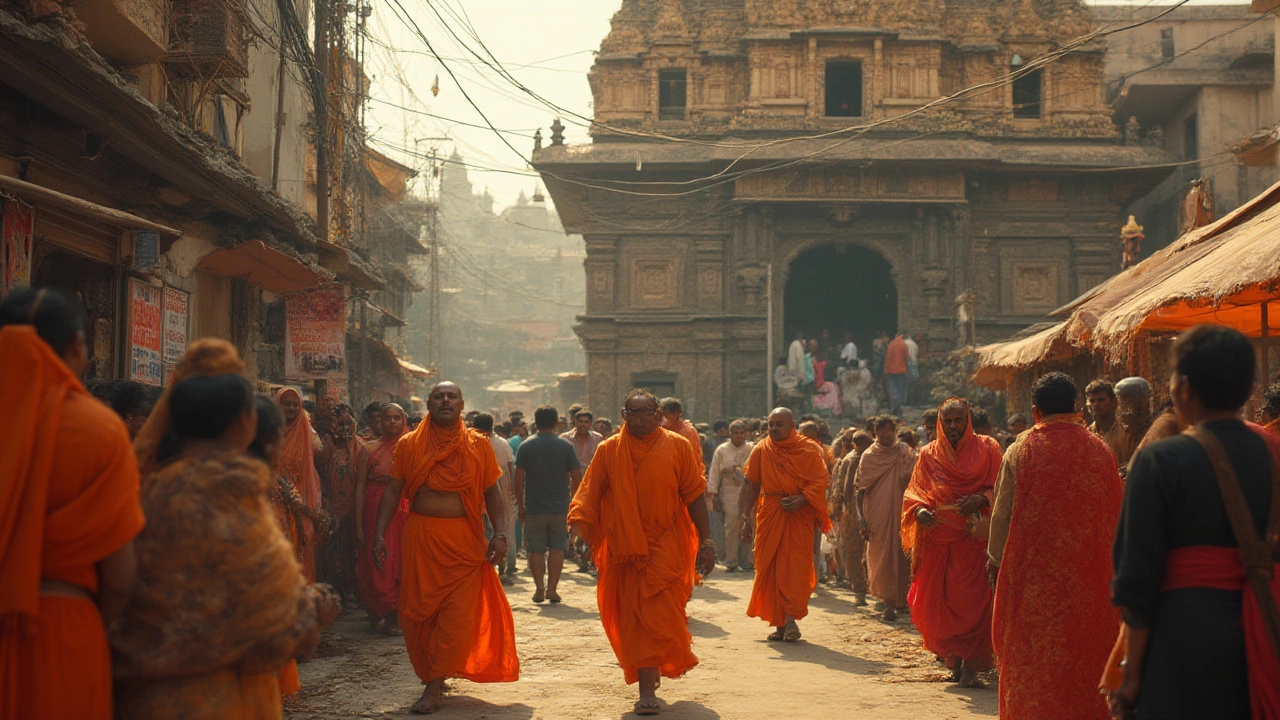When Should You Avoid Going to the Temple? Critical Times to Skip Your Visit
 Jul, 4 2025
Jul, 4 2025
Picture this: the air is heavy with incense, bells tinkle in the distance, and rows of devotees quietly bow their heads. But should everyone go to the temple, no matter what? Turns out, there are very practical, and sometimes surprising, times when you should skip the visit—holding back out of respect for tradition, health, or the spiritual comfort of others. People don’t usually think about this part of ritual life, but knowing when not to go to the temple can make as much difference as knowing when you should.
Timing Is Everything: Festivals, Crowds, and Personal Rhythms
We've all heard friends say, “I only go to the temple during the big festivals!” Sure, Diwali, Navratri, or Easter Sunday draw crowds like nothing else. But is the festival rush the best time to show up? Sometimes the practical answer is no. Temples during festivals can get so packed that you barely get a second to connect with your faith. Long lines snake outside, shoes pile up at the gates, and local police are sometimes roped in to control the human traffic. A quick search shows that during the Kumbh Mela in 2019, more than 50 million people gathered at Prayagraj—try finding a moment of peace in all that!
Bigger crowds can mean higher risk, too. Seasoned devotees know to avoid temples during peak Covid outbreaks, the flu season, or after seeing news of an outbreak in the area. Most temple management committees follow public health advisories, shutting doors or restricting gatherings when situations get risky. But even without a government order, it’s thoughtful to ask yourself if heading into a crowd makes sense—for you and for everyone else.
There’s also the question of timing in your own life. Many traditions quietly discourage temple visits when you’re going through a deeply personal storm. If grief has left you raw or your mind feels scattered, waiting until your inner rhythm matches the temple’s peaceful rhythm can actually help your prayer feel more genuine.
States of Purity: Why Physical and Emotional Cleanliness Matters
Ever heard your grandmother say not to visit the temple when you’re unwell? There’s more to it than old wives’ tales. Almost every major religious tradition links the concepts of purity and cleanliness with worship. Hindu, Buddhist, Christian, and Sikh temples all have specific guidelines about who should enter and when. In Hindu customs, for example, menstruation is considered a natural process, but tradition generally dictates avoiding temple visits during those days. This isn’t meant as a judgment, but as a sign of respect for centuries-old spiritual codes.
Contagious illness is something else entirely. Influenza, chickenpox, or a stomach bug mean you should stay away. Not just for your own well-being, but for the community’s safety. There was that study from the Indian Journal of Community Medicine back in 2021 showing higher rates of viral spread in densely populated temple spaces—especially in poorly ventilated halls. So next time you’re running a fever, consider making your prayers from home.
Physical purity isn’t the only thing. Most traditions regard emotional states as just as important. For many, anger, jealousy, or heavy emotional turmoil are grounds for sitting out a temple trip. This isn’t about shame—it’s about being fully present. Temples aren’t just buildings; they’re meant to be spaces where you reset, reflect, and invite calm. If your mind is storming, time to cool off before your next visit.

Respect, Reverence, and Ritual: Special Circumstances When You Shouldn’t Go
Plenty of guidelines aren’t spelled out on posters at the entrance, but they matter. Have you lost a close family member recently? Many Hindu customs call for a period of ritual impurity (usually 10–13 days), during which the bereaved family should not enter temples. Even among Christians and Buddhists, mourning may come with its own set of ‘pause’ buttons for ritual participation.
Other times, the event itself means staying away. When priests are performing certain high-level rituals—like consecration ceremonies or annual deep cleansings—temples may be closed to the public. It’s not personal; it’s tradition. If you’re unsure, just ask. Temple staff or regular devotees can give you the lowdown on what’s happening that week, especially before showing up for an unexpected dose of incense and quiet only to find the doors locked.
Some restrictions are unique to spiritual roles. In certain religions, people in training to become priests, monks, or nuns may have temporary bans on visiting the main sanctum until initiation is complete. And children? Many temples have age minimums for certain rituals—sometimes for security, sometimes just to keep the atmosphere peaceful for everyone involved.
Here’s a quick look at special circumstances when visits are discouraged:
- During mourning periods after a death in the family
- When under vows of silence or specific spiritual disciplines
- If you’ve broken certain ritual taboos (best clarified by tradition or elders)
- Before major temple rituals, when access is restricted
- For those not initiated into certain faiths or rituals
Public Health, Safety, and the Bigger Picture
It’s easy to forget that temples are like any other popular spot—they pose risks during public emergencies. Lockdowns in 2020 taught us what can happen when huge groups gather, even with good intentions. Major temples in India, for instance, were closed for weeks during Covid’s worst months. Even after reopening, you could see staff checking temperatures, handing out masks, and sometimes turning away visitors who looked ill.
Not all the risks are viral. During natural disasters—floods, earthquakes, forest fires—temple doors are likely to close, too. In 2023, thousands were told to stay away from shrines in northern India as heavy monsoon rains flooded hill roads and temples alike. Sometimes, safety comes first, even before spiritual routine.
Here’s a little visual aide. Take a look at recent temple closures around the world and their causes.
| Year | Country | Event | Reason for Closure |
|---|---|---|---|
| 2020 | India | Covid-19 pandemic | Public health emergency |
| 2021 | Nepal | Festival Surge | Overcrowding risk |
| 2023 | Japan | Typhoon | Natural disaster |
| 2022 | USA | Community Outbreak | Flu spread |
Just because the calendar says it’s a special day doesn’t mean it’s safe to visit. The most regular temple-goers I know never hesitate to prioritize health and safety before ritual. If you see yellow tape, police cordons, or "Temporarily Closed" signs, that’s your cue to turn around. Try visiting the temple’s official website or social media channels before heading out, since updates are posted there first.

Temple Etiquette Tips: Making Thoughtful Choices
Navigating the ‘when not to go’ can be just as delicate as following ‘when to go.’ You don’t need to memorize hundreds of rules, but some simple etiquette tips make things smoother for everyone. If you’re coughing, sneezing, or on heavy medication, it’s totally okay to sit it out for a few days. If you’re bringing children, check whether there are specific timings or areas for them. Some temples limit access for very young kids during special prayers and ceremonies.
Dress codes are another underappreciated reason you might be asked not to enter on a particular day. If you show up in shorts, sleeveless shirts, or clothing considered inappropriate by local standards, expect a polite but firm request to come back dressed more respectfully. During summer, I once saw a group of college students turned away from a famous Chennai temple—they simply didn’t know about the ‘no shorts’ rule. A quick search on the temple’s website or community noticeboard can save you the hassle and the embarrassment.
Most importantly, remember that rules and customs aren’t there to shame or exclude—they’re about sustaining a sacred space for everyone. If you don’t know whether you should visit, or if you’re worried you might offend, just ask. Regular devotees or temple volunteers are the best people to approach. They’ve seen every scenario—first-timers, confused tourists, and regulars alike. They’ll help you find the best way to participate, or the gentlest way to wait out your visit until the time is right.
Pay attention to the little things: cleanliness, state of mind, respect for current rituals, and health advisories. These factors shape the energy of the temple, for you and for everyone else. Sometimes, the most temple etiquette comes from listening—to your body, the community, and the spiritual moment. That’s how you keep the sacred, well, sacred.